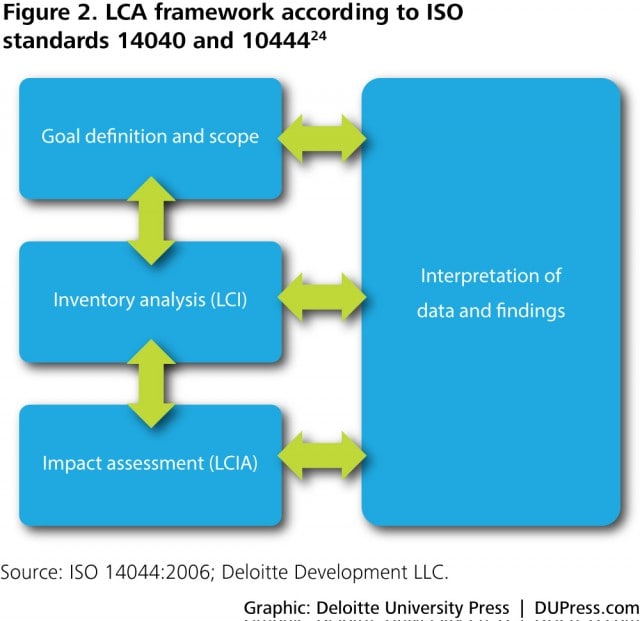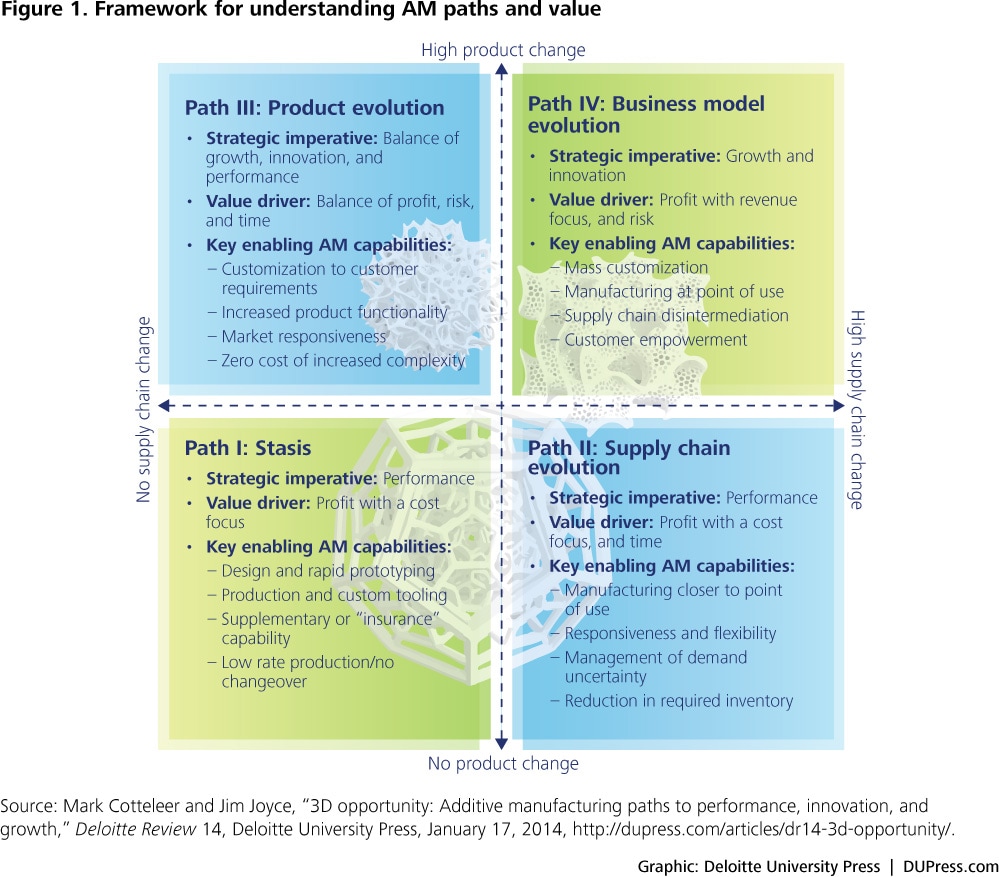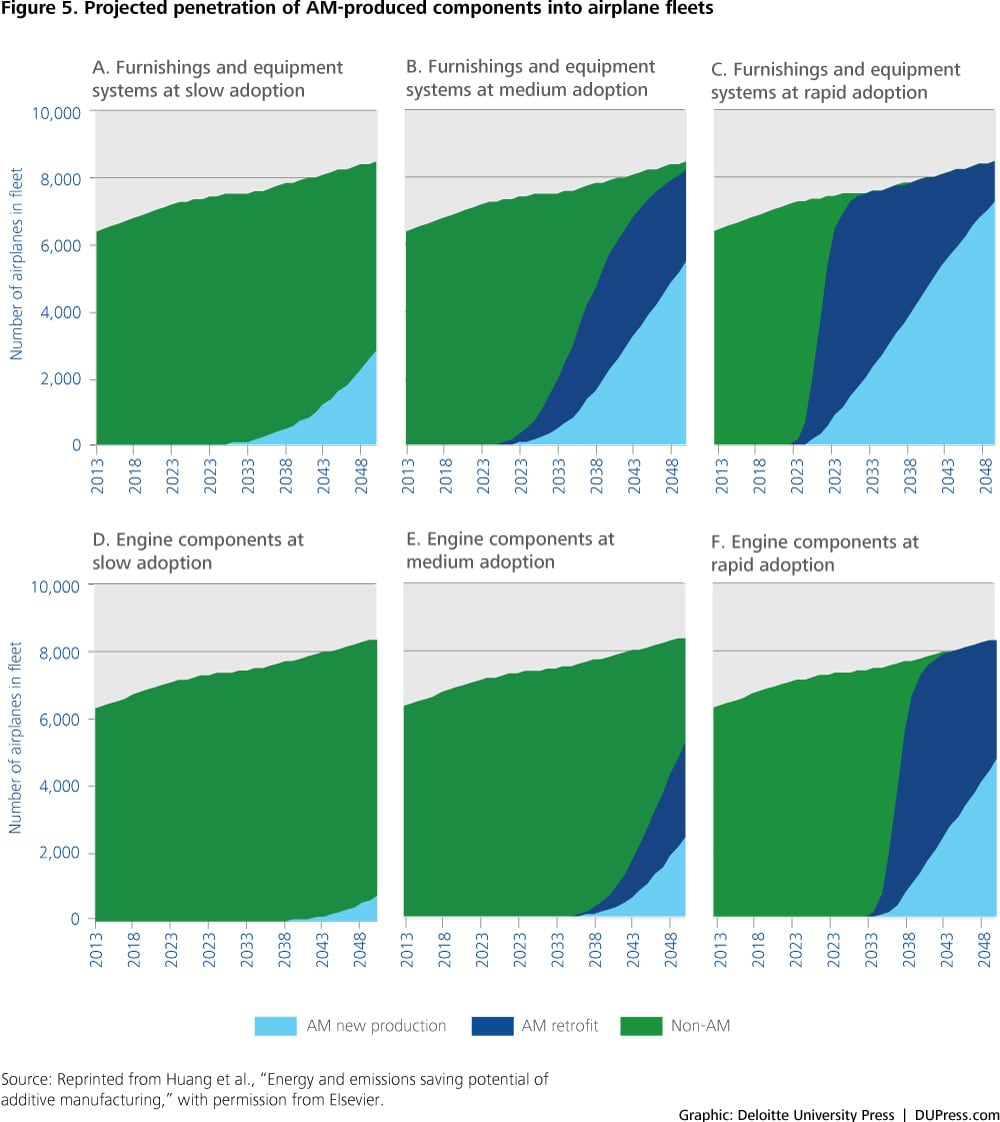3D opportunity for life cycle assessments has been saved

3D opportunity for life cycle assessments Additive manufacturing branches out
17 October 2015
Life cycle analysis (LCA)—traditionally used to assess environmental impacts—can also help quantify the potential savings of adopting additive manufacturing techniques, allowing companies to look beyond traditional cost models and metrics to more holistically determine how AM may benefit the business.
Introduction
Want to learn more about 3D printing?
Visit the 3D Opportunity collection
Register for our upcoming course
Colloquially known as 3D printing, additive manufacturing (AM) offers myriad advantages in terms of labor, materials, speed to market, and prototyping and design.1 It can also be more cost-effective than conventional manufacturing in situations that involve long lead times, high inventory costs, complex or expensive parts, and remote locations where sourcing and shipping are difficult.2 To realize the potential benefits of AM, however, inherent challenges must be managed, including limitations on volume, size, and range of materials, many of which make conventional manufacturing better for some products.3 These trade-offs are, by now, well established in the AM literature.
Companies may need to look beyond traditional cost models and metrics to more holistically determine the impacts of AM adoption.
With an increasing number of manufacturers considering the adoption of AM in their supply chains, companies should be able to evaluate whether AM makes sense for their particular purposes. To do so might require looking beyond traditional cost models and metrics to more holistically determine the impacts of AM adoption. Life cycle assessment (LCA) adds an important perspective, enabling companies to more fully evaluate this critical decision. The goal of an LCA is to understand the environmental impact of bringing a product or service to the market.4 An LCA evaluates an expanded set of inputs at their rawest form across each stage of the life cycle, from extraction or development of raw materials through processing, manufacturing, use, and end-of-life disposal.
Over the past five years LCAs have become increasingly common at the world’s leading companies. R&D departments within companies such as Kimberly-Clark,5 universities such as the Georgia Institute of Technology,6 and government researchers at the Environmental Protection Agency7 and National Science Foundation8 all use LCAs to assess environmental impact. Likewise, the National Center for Defense Manufacturing and Machining serves on the board of the Mission Ready Sustainability Initiative, a project devoted in part to using “streamlined” LCAs to promote sustainability in product and service acquisition.9
The body of research around LCA application is growing. One study suggests that the number of scientific publications involving LCA more than doubled between 2009 and 2011.10 Research also makes the link between sustainability and value creation, by demonstrating how the application of LCAs can provide useful insights for business decisions.11
Although LCA has primarily been used to assess the environmental impact of processes, LCA assessments can—and have—also helped to quantify the total cost savings of AM adoption. By exploring LCA models and their applications, this paper introduces an approach for better estimating the material and energy impact of AM technologies, allowing operations and finance leaders to determine whether to incorporate AM into their supply chains.
The additive manufacturing framework
AM is an important technological innovation that helps manufacturers break existing performance trade-offs in two fundamental ways. First, AM helps reduce the capital involved in achieving economies of scale. Second, it can increase flexibility and reduce the capital needed to achieve scope.12
Capital versus scale: AM has the potential to reduce the capital required to reach minimum efficient scale for production, thus lowering the barriers to entry for manufacturing in a given location.
Capital versus scope: The flexibility of AM can facilitate an increase in the variety of products a unit of capital can produce, reducing the costs typically associated with production changeovers, customization, and the overall amount of necessary capital.
Evaluating the capital versus scale relationship through LCA modeling allows manufacturers to begin to understand the many different efficiencies AM can create throughout the supply chain (see figure 1), and enables companies to choose between four tactical paths to deploy AM across their businesses:
Path I: Companies do not radically alter their supply chains or products, but they may explore AM technologies to help improve value delivery for current products within existing supply chains.
Path II: Companies take advantage of scale economics offered by AM to help transform supply chains for the products they offer.
Path III: Companies take advantage of the scope economics offered by AM technologies to enable new levels of performance in the products they offer.
Path IV: Companies alter supply chains as well as products in pursuit of new business models.
Additionally, this paper focuses on an example from the aerospace industry, in which researchers at Northwestern University used LCA to assess 3D-printed aircraft components, and thus were able to quantify savings related to energy consumption, fuel, and emissions.13 The findings of this analysis also apply to other industries trying to understand the potential impacts of replacing conventionally manufactured components with AM-created alternatives.
While other resources are required to analyze the impacts of improved scope, the LCA model presented in this paper can help companies evaluate AM adoption from a scale perspective, allowing them to tangibly quantify the material and energy savings offered by AM technology across a supply chain. Companies can decide which of the four paths they should pursue based on an LCA analysis along with a separate analysis of the impacts to scope.
Traditional decision making in AM adoption
When considering machinery investments for traditional manufacturing, producers typically develop in-depth cost models to examine direct costs, such as raw materials and labor, as well as other indirect costs—production overhead, machine maintenance costs, and so on—to determine whether an investment is justified.14 Evaluation of similar factors is recommended when constructing a business case for additive manufacturing.15
In hewing only to traditional cost models, business leaders may not be seeing the full financial and environmental benefits they could achieve from employing AM.
Thinking in these terms alone, however, may be limiting, as these elements may not reveal the full picture of the value offered by AM. For example, AM can be more environmentally friendly than more conventional manufacturing methods.16 Beyond generating less material waste, AM’s use in a supply chain along path II can help reduce the need for shipping and transportation, resulting in fewer emissions.17 In addition, AM can decrease the need for other environmentally detrimental materials, including cutting fluids that may be caustic or hazardous;18 and the lighter weight of many AM-produced parts can help save fuel and energy.19
Thus, in hewing only to traditional cost models, business leaders may not be seeing the full financial and environmental benefits they could achieve from employing AM. Indeed, many analyses that include a quantification of AM’s environmental impact have been somewhat limited, focusing on criteria such as standby and in-process electrical consumption.20 They may lack additional measurements, such as waste flows, resource consumption, and emissions generated during production, which provide a more complete picture.21
Without an estimate of the returns from using 3D printing that involves this wider set of factors, many may not understand where to employ the technology, and they may not account for the opportunities AM presents for greater environmental optimization. Using LCA to model some of these secondary impacts—primary energy savings or greenhouse gas emissions, for example—may provide additional incentive and guidance regarding where to invest.
Performing a life cycle assessment
Businesses and government agencies primarily use LCAs to assess the “potential human health and environmental impacts” of resources used and emissions released during production, and LCAs typically span the full life cycle of a product.22 The International Organization for Standardization (ISO) provides a set of standards and a framework—ISO 14040:2006 and ISO 14044:2006—for LCAs and their relevant stages (see figure 2).23 Here we briefly describe these steps.
 see endnote 24.
see endnote 24.
Goal definition and scope: Setting system boundaries
When developing a life cycle inventory (LCI), the first step is to define the scope of the analysis as well as the boundaries of the system. The scope can encompass either the cradle-to-gate (a product’s lifespan from raw materials through the moment it leaves the manufacturing plant) or the full cradle-to-grave lifespan (a product’s full lifespan from raw materials, processing, and manufacturing, through use, disposal, and any potential reuse, repurposing, or recycling) of a product. The boundaries can include detailed data on all components of the supply chain. In other cases, however, the system boundaries can often be limited by the available information or research constraints.25
Inventory analysis: Executing an LCI to collect and track environmental impact against standardized data sets
One of the most crucial stages of an LCA is the LCI, in which data are collected to account for all inputs and outputs to the system, encompassing the entire supply chain. These data can include raw materials; energy used; water and other fluids as inputs; and emissions, including what types and where they are emitted, and where outputs end up (such as bodies of water, air, or landfills).26 Due to the complexity of supply chains, the number of inputs and substances involved, and the amount of information and processes that take place, LCI models can be extremely complex.
The LCI model provides a standardized methodology to help ensure consistency across LCAs, making it possible to compare different product and vendor alternatives. The LCI serves as a lynchpin of sorts for conducting an LCA, offering a framework to quantify requirements and resulting processes and products, and providing a consistent top-down method to estimate impact on savings.
Many LCI models are being validated and aggregated into national databases to standardize and track environmental effects, making the development of new models easier. For example, the Cooperative Effort on Process Emissions in Manufacturing initiative has developed methodologies to systematize inventory analysis of emissions generated via manufacturing and production. The goal is to store these standardized data sets and specifications in LCI databases for reference and use in LCAs, as well as provide guidelines for improving manufacturing.27
Understanding a system’s components requires extensive research. This can start with surveys of the major elements of the supply chain—probing into the raw materials and energy resources required to deliver a product’s inputs. Otherwise, secondary sources, such as industry studies or national databases, can be used as proxies.28 Once the list of inputs and outputs at the system boundaries is established, the data are collected to complete the model.
Impact assessment: Understanding the inputs and their impact
A life cycle impact assessment (LCIA) evaluates the information gathered during an LCI to understand the environmental impacts of any outputs identified during the inventory analysis. While this phase may not expressly quantify the impacts associated with any one specific process, it can serve to link or correlate a system with specific impacts.29 In this way, the relative impact of two approaches—say, that of AM versus conventional manufacturing—can be compared to ascertain where each may have a more favorable impact.
In practice: When the LCIA stage uncovers differences between additive and conventional manufacturing
A recent LCA compared conventional manufacturing using a computer numerical control (CNC) mill with both fused deposition modeling (FDM) and PolyJet to create two parts made of ABS plastic (or a similar material).30 The LCA took a cradle-to-grave scope, and the LCI model catalogued “impacts, transportation, energy used during manufacturing, energy used while idling and in standby, material used in final parts, waste material generated, cutting fluid for CNC, and disposal.”31 By comparing all three approaches while manufacturing the same parts, the LCIA revealed that the utilization rate had the greatest impact on which approach was the most sustainable. The AM approaches were impacted most heavily by electricity usage. When operating at maximum production, CNC machining was impacted most heavily by material waste and, to a lesser extent, cutting fluid. In the end, the LCIA found that FDM had the lowest environmental impact, while PolyJet’s ability to perform better than CNC depended on utilization and other factors.32
Interpreting findings and determining next steps: Once an LCIA is complete, the findings are then evaluated and interpreted using a systematic process. According to the ISO, the interpretation phase is meant to analyze the results to provide recommendations based on the information uncovered by the LCIA—and to help ensure the findings fall within the goal and scope established in the first stage of the LCA.33
Understanding the trade-offs
Despite their value, LCA and LCI models can, in some cases, be limited. The essential trade-off in using these models lies between precision and scope. At its heart, the LCI model provides a systematic approach to evaluating environmental effects associated with a product or service at a system level, along with a consistent method for analyzing different products and services. However, the accuracy of the model is highly dependent on the detail and veracity of the available data sources, and it struggles to account for variance in costs, either of raw materials or energy, across the supply chain.
Thus while the LCI model can enable an end-to-end, aggregated view of consumption, it sacrifices the nuances and variances that exist across the value chain. To overcome this, businesses can augment the LCA with financial models for a deeper understanding of direct financial impacts.34
The case study below demonstrates how one assessment was conducted using LCA to understand impacts resulting from employing AM in lightweight aircraft component systems.35
Case study: Modeling energy and emission savings potential in lightweight aircraft components
The aerospace industry has been at the forefront of AM adoption.36 While experimentation has started with small, noncritical parts, the dynamic nature of the aerospace industry makes broader adoption attractive. An operating aircraft consumes an immense amount of energy, and small changes in weight can significantly affect the associated costs and emissions. In addition, a great deal of metal scrap is often lost during the aircraft production process—with the ratio of raw metal input to completed component mass (the “buy-to-fly” ratio) often ranging from 12:1 to 25:1.37 Taken together, fuel savings and scrap reduction can provide significant value to both aircraft manufacturers and operators (for example, airlines and the military).
In light of these potential impacts, an LCA focused on parts eligible for near-term adoption within the aerospace industry. A group of researchers at Northwestern University’s McCormick School of Engineering, including one of this paper’s authors, analyzed the component systems in an aircraft to estimate the net impact of switching the production of eligible candidates to AM processes. Comparing the assessments with and without AM adoption, they projected the annual and cumulative material, energy, and emissions impact through 2050.38
Developing and defining an LCA
The LCA analysis proceeded as follows (also see figure 3):
First, scope and system boundaries were set using established selection criteria to identify candidate component systems. For the comparative AM configuration, the set of which eligible component systems could be replaced, such as wing components, brackets and clips, and seats, was approximated using secondary sources that included previously published case studies and industry targets from companies experienced in using AM for aerospace production.
Second, a model was developed to estimate total energy and emissions during production under both AM and more traditional manufacturing methods. Academic studies were used to construct baseline estimates. For the AM comparison, an adoption model was constructed to account for AM penetration over time; then an aircraft fuel use model was employed to calculate projected fuel and emissions during aircraft operations for both cases.
Third, the two cases—the base conventional manufacturing consumption and the projected consumption from AM production scenarios—were compared to understand the impact of adoption. This assessment resulted in an estimate of materials and energy savings, against which estimated costs of component design and manufacturing changes could be compared.
Selecting the component systems to include within the assessment scope was driven by a feasibility scoring method that was determined using three steps:
- Noncritical systems made primarily of metallic components were selected.
- System mass was subdivided into structural, functional, and auxiliary categories.
- Each component system was graded on three characteristics: load rating, shape complexity, and geometric volume.
Grades were summed, and systems with feasibility scores above five were included in the model.39
The mass of the key metal alloys typically used in aircraft components—aluminum, titanium, nickel, and steel—was analyzed using case studies and industry targets. Based on an empty 40,622-kilogram 142-seat commercial aircraft, an estimated 9–17 percent of average mass was estimated as replaceable with AM components, given the component systems included within the assessment scope. Using this range, the LCI model was used to estimate savings.
For the LCIA, a model was constructed to capture the energy use and emissions from the component-system manufacturing process—limiting the scope to cradle to gate. This scope is defined by four key phases: raw material production, materials distribution, component manufacturing, and component distribution. Within the boundaries of each phase, the key processes were compared (see figure 4): mining, ingot casting, milling (for conventional manufacturing), and selective laser printing (SLM; for printing).40
Assessing the outputs
With the model defined, the materials and energy savings were assessed based on literature reviews on buy-to-fly ratios, transportation distances, and manufacturing energy and emissions for the selected component systems. For the selected components, the buy-to-fly ratio dropped from 4.5–8.0 under conventional manufacturing to 1.5 across all AM processes, reducing overall material scrap. Through redesign, average estimates for the reduction of empty aircraft mass was 4–7 percent, driven largely by engine system components, aluminum alloy–based furnishing, and equipment components such as seat buckles and brackets. These materials savings translated into energy and emission reductions. The engine component replacements resulted in savings of up to 7,200 gigajoules of energy and 550 metric tons of CO2-equivalent emissions per aircraft annually—contributing more than 50 percent of the total value.41
The adoption model was built based on the Bass diffusion curve, the classic S-curve model frequently used to estimate technology penetration.42 Each component system was analyzed by component category to assign an expected time of AM replacement availability, ranging from 5 years (for some furnishing and nacelle components) to 20 years for functional engine components. Three adoption scenarios were run on the model (see figure 5):
- Slow: AM parts introduced only in new aircraft, with each component taking 28 years to reach 80 percent adoption
- Medium: AM parts incorporated into new aircraft and replacing parts in existing aircraft, with each component taking 15 years to reach 80 percent adoption
- Rapid: AM parts incorporated into new aircraft and replacing parts in existing aircraft, with each component taking 5 years to reach 80 percent adoption
The adoption model enabled the estimation of annual fuel and emissions savings resulting from mass reduction—estimated across scenarios based on an annual reduction of 0.45–0.67 terajoules, or approximately 3,200-4,700 gallons of kerosene-type jet fuel for each 100 kilograms reduced.43 This results in savings of $9,100–13,400 per 100 kilograms per year, constituting a major impact over the 30-year lifespan of an average airplane.44 Assuming full adoption of AM, an airline could realize up to 6.4 percent fuel savings per aircraft, and, for the entire industry, $2.9 billion in a single year for US carriers, based on 2014 consumption.45
Under the rapid adoption scenario, complete life cycle savings in primary energy consumption ranged from 70–173 million gigajoules per year by 2050. For the full range of primary energy impact scenarios, see figure 6.
The bulk of cumulative energy derived from fuel consumption is during aircraft operation. Fuel savings from AM adoption accounted for 95–98 percent of these energy savings under the medium scenario, driven largely by replaced furnishings and equipment components. Conversely, the largest portion of savings during AM manufacturing came from engine parts, as they consumed more energy during production.
This analysis highlights some interesting dynamics in the AM adoption process, and it can serve as a guide for aircraft operators and manufacturers on how and where to invest in AM. The research revealed potential benefits of AM implementation to both original equipment manufacturers (OEMs) and aircraft operators, with potential for significant savings in terms of both materials and energy consumption.
Analysis revealed that the deployment of AM aimed at furnishing system components is most immediately attractive for aircraft operators—a result of potential fuel savings due to the large potential of weight reduction. Conversely, engine systems appear to be attractive targets for OEMs, due to potential savings in the production process from waste reduction in titanium, nickel, and other metal alloys. Due to some of the challenges facing the deployment of metal engine components, it seems likely that deployments in the engine space will lag those for less demanding applications in furnishings.46
Armed with this analysis, leaders in both OEM and aircraft operators can discuss trade-offs and timing of AM implementations rather than continuing to rely on more conventional manufacturing methods.
Conclusion
Additive manufacturing presents business leaders across numerous industries with an opportunity to improve existing designs and processes, while also highlighting the potential for more complex and intricate designs. As a result, the technology is seeing increased adoption beyond prototyping, making inroads within some sectors into tooling, replacement parts, final production, and other areas. However, with widespread implementation still emerging, experience around AM’s potential benefits is not deep, and therefore the best opportunities for initial use and impact are still being determined. Making longer-term investment decisions in AM can seem uncertain, with the process for prioritizing opportunities still a work in progress.
To enhance the decision-making process, business leaders can benefit from a more systematic way of identifying opportunities—one that can better highlight potential benefits of AM.
To enhance the decision-making process, business leaders can benefit from a more systematic way of identifying opportunities—one that can better highlight potential benefits of AM. Life cycle assessment and inventory modeling can provide such a methodology by focusing on the material and energy savings seen across the supply chain, production, and use. Using this method, companies can hone in on prime targets (such as furnishing and equipment in aircraft) for immediate investigation.
As companies continue to consider the adoption of AM and look to LCA modeling to identify opportunities, here are some key actions to take:
Consider the role of LCA in decision-making processes related to AM adoption. This approach can reveal efficiencies inherent in AM that may not be readily apparent in traditional cost modeling, so LCA can play an important role in the decision-making process.
Take inventory of current materials used in key components. Companies looking to substitute AM parts for conventionally manufactured ones should first understand the breadth of raw materials used in their products and component parts. Prioritizing materials according to volume used, energy required to process, and scrap ratio can help managers begin to assess their impact within the model. It will be important to stay abreast of AM’s process and technology improvements, as these could shift the economics that drive decision making.
Establish priority criteria for replacement. Design requirements and specifications vary greatly across applications. Businesses seeking to take near-term advantage of AM, whether for scrap material savings or design efficiency, should understand the trade-offs associated with AM processes. Also, managers should seek to understand the characteristics critical to the market success of their products (for example, geometric precision and structural integrity) to ensure that these are not at odds with the current AM-related trade-offs. Initial successes in adoption, even if auxiliary, can provide a great deal of learning and potential savings upon which to build momentum.
Leverage existing LCA models and LCI databases. With many LCA models being built by businesses and government agencies pursuing sustainability, there is a great deal of knowledge than can already be leveraged for under-resourced managers. Using publicly available research and models can accelerate the assessment process. By focusing incremental effort on enhanced assessment and deeper analysis (such as around projected development costs, switching costs, and penetration time), leaders can develop more complete business cases for targeted AM investment and deployment.
Some business leaders interested in understanding AM’s inherent impact and harnessing its potential benefits would benefit from using a systematic approach such as LCA, which considers the technology’s trade-offs, to better prioritize their development investments.
Deloitte Consulting LLP’s Supply Chain and Manufacturing Operations practice helps companies understand and address opportunities to apply advanced manufacturing technologies to impact their businesses’ performance, innovation, and growth. Our insights into additive manufacturing allow us to help organizations reassess their people, process, technology, and innovation strategies in light of this emerging set of technologies. Contact the authors for more information, or read more about our alliance with 3D Systems and our 3D Printing Discovery Center on www.deloitte.com.
© 2021. See Terms of Use for more information.









